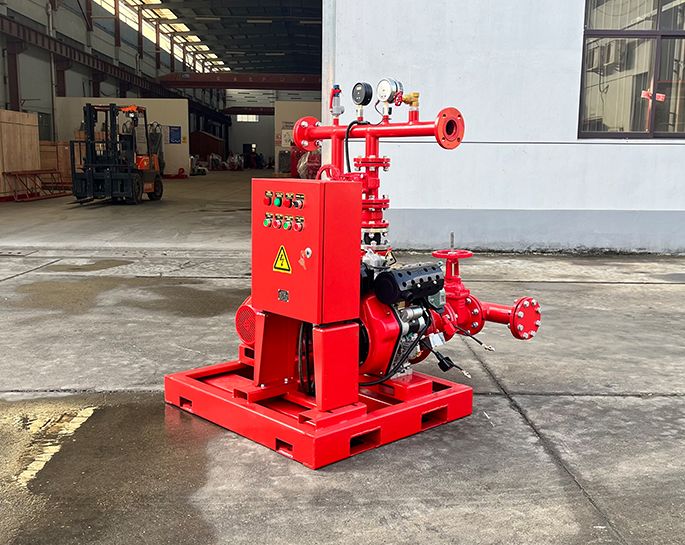What are the factors influencing the selection of a fire pump set?
May 09, 2024
Share:
Selecting a fire pump set involves considering several factors to ensure it meets the specific requirements of the building or facility it will protect. Here are some key factors that influence the selection process:
1. **Water Supply**: The availability and reliability of the water source, whether it's from a municipal water system, a well, a reservoir, or a dedicated water tank, are crucial. The fire pump set should be capable of drawing water from the source efficiently.
2. **System Design**: The design and layout of the fire protection system, including factors like the required flow rate, pressure, pipe size, and layout, will dictate the pump's specifications. This includes considerations for sprinkler systems, standpipes, hydrants, or other fire suppression systems.
3. **Building Size and Occupancy**: The size, occupancy type, and construction of the building influence the pump's capacity and performance requirements. Larger buildings or those with high occupancy may require more powerful pumps.
4. **Local Codes and Regulations**: Compliance with local building codes, fire codes, and regulations is essential. These regulations may specify requirements for pump performance, installation, and maintenance.
5. **Risk Assessment**: A thorough risk assessment helps determine the level of fire protection required. High-risk facilities such as chemical plants or warehouses storing flammable materials may require more robust fire pump systems.
6. **Reliability and Redundancy**: Reliability is critical for fire pumps, as they must operate during emergencies. Redundancy, such as backup power sources or redundant pumps, may be necessary to ensure continuous operation.
7. **Environmental Conditions**: Factors like climate, temperature, altitude, and potential exposure to corrosive or harsh environments can affect the selection of materials and pump design.
8. **Budget and Lifecycle Costs**: The initial cost of the pump set, as well as ongoing maintenance and operational expenses, should be considered. Balancing performance requirements with budget constraints is essential.
9. **Manufacturer Reputation and Support**: Choosing a reputable manufacturer with a track record of quality products and reliable support services can enhance the longevity and effectiveness of the fire pump system.
10. **Future Expansion and Flexibility**: Consideration should be given to potential future expansion or changes in building use that may require modifications to the fire protection system. Selecting a pump set with scalability and flexibility can accommodate future needs.
By carefully evaluating these factors and working with qualified engineers or consultants, stakeholders can select a fire pump set that provides effective and reliable fire protection for their specific application.

1. **Water Supply**: The availability and reliability of the water source, whether it's from a municipal water system, a well, a reservoir, or a dedicated water tank, are crucial. The fire pump set should be capable of drawing water from the source efficiently.
2. **System Design**: The design and layout of the fire protection system, including factors like the required flow rate, pressure, pipe size, and layout, will dictate the pump's specifications. This includes considerations for sprinkler systems, standpipes, hydrants, or other fire suppression systems.
3. **Building Size and Occupancy**: The size, occupancy type, and construction of the building influence the pump's capacity and performance requirements. Larger buildings or those with high occupancy may require more powerful pumps.
4. **Local Codes and Regulations**: Compliance with local building codes, fire codes, and regulations is essential. These regulations may specify requirements for pump performance, installation, and maintenance.
5. **Risk Assessment**: A thorough risk assessment helps determine the level of fire protection required. High-risk facilities such as chemical plants or warehouses storing flammable materials may require more robust fire pump systems.
6. **Reliability and Redundancy**: Reliability is critical for fire pumps, as they must operate during emergencies. Redundancy, such as backup power sources or redundant pumps, may be necessary to ensure continuous operation.
7. **Environmental Conditions**: Factors like climate, temperature, altitude, and potential exposure to corrosive or harsh environments can affect the selection of materials and pump design.
8. **Budget and Lifecycle Costs**: The initial cost of the pump set, as well as ongoing maintenance and operational expenses, should be considered. Balancing performance requirements with budget constraints is essential.
9. **Manufacturer Reputation and Support**: Choosing a reputable manufacturer with a track record of quality products and reliable support services can enhance the longevity and effectiveness of the fire pump system.
10. **Future Expansion and Flexibility**: Consideration should be given to potential future expansion or changes in building use that may require modifications to the fire protection system. Selecting a pump set with scalability and flexibility can accommodate future needs.
By carefully evaluating these factors and working with qualified engineers or consultants, stakeholders can select a fire pump set that provides effective and reliable fire protection for their specific application.


.png)
.png)

.png)


